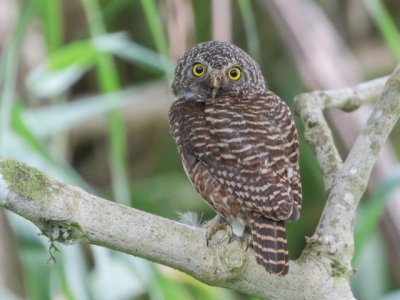
Taenioptynx brodiei, also called the collared owlet or collared pygmy owl, is the smallest owl found in Asia. It measures between 15 and 17 cm and weighs between 52 and 63 gms. This diminutive owl belongs to the family Strigidae and unlike most owls, is diurnal in nature.
It is gray-brown in colour with a barred back and sides. It has white eyebrows, lemon-yellow eyes and a white throat patch. Its chin, chest and belly are covered in white feathers and ear tufts are absent. It has two black spots on each side of the back of its head, making it seem like it is watching from behind! These false eyes can confuse potential predators and are present in many pygmy owl species. This feature is called the pygmy owl ‘occipital face’.
This bird has a very unique call – ‘wup-wuwu-wup’, which is made while turning its head in all directions. This creates a ventriloquial effect and it is difficult to locate the owl due to this. It hunts during the day and perches on a sparsely foliaged branch looking out for prey. It eats mice, insects, lizards, small birds and worms.
Its natural habitat is submontane and montane forests (forests formed on the slopes of mountains) and is found throughout Asia in countries like India, Bangladesh, Laos, Bhutan, Cambodia, China, Afghanistan and Malaysia. It is a resident bird across its habitat range and is a secondary cavity nester. This means it will occupy nests and tree hollows built by other bird species. It lays between 3 and 5 eggs and incubation occurs over 4 weeks. This species is listed under ‘Least Concern’ on the IUCN Red List and is mainly threatened by habitat loss.
Picture Credit : Google




